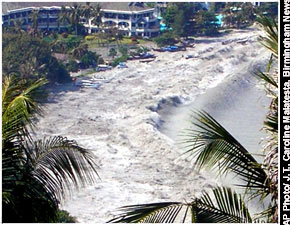Quake Death Toll in 2004 Could Be Worst Since 1556

A final analysis of the Indian Ocean earthquake and tsunami is likely to create a death toll in 2004 greater than any caused by ground shaking in more than four centuries.
While the total deaths from the Dec. 26, 2004 disaster remains uncertain, it stands at 275,950, according to a U.S. Geological Survey (USGS) statement released Thursday. A comparatively small number of other earthquake-related fatalities for the year brings the total to 276,856, the agency reported.
However, other disaster officials put the known deaths at between 162,000 and 178,000, with a list of missing between 26,000 to 142,000. Those figures add up to a possible death toll range of between 188,000 and 320,000.
It remains to be seen whether the final tally will exceed 1976, when a magnitude 7.5 temblor killed roughly 255,000 people in and around Tangshan, China.
On Jan. 23, 1556, a quake thought to have been magnitude-8 killed an estimated 830,000 people in Shansi, China.
Historically, most earthquake deaths are caused directly by the shaking. But tsunamis and fires have contributed to combined catastrophes before. In 1755, an earthquake in Lisbon, Portugal triggered a tsunami and fires that combined to kill more than 60,000 people.
Recent large earthquakes
Get the world’s most fascinating discoveries delivered straight to your inbox.
The Dec. 26, 2004 earthquake was put at magnitude 9.0 initially. One group of scientists said earlier this week it was actually 9.3. As of Thursday, however, the USGS was still using the 9.0 figure. Depending on what number geologists ultimately settle on, it will go down in history as the second or third strongest event ever measured.
The all-time largest, magnitude 9.5, hit Chile in 1960.
In 2004, just three days before the Indian Ocean earthquake and tsunami, another large earthquake -- magnitude 8.1 -- struck north of Macquarie Island, about a thousand miles southwest of New Zealand. There were no reported deaths.
Prior to that, the last great earthquake was a magnitude 8.3 in Hokkaido, Japan, in September of 2003.
In 2003, 33,819 deaths were attributed to earthquakes; about 31,000 owing to a magnitude 6.6 temblor that struck Bam, Iran on Dec. 26 of that year. In 2002, 1,711 people were killed by earthquakes.
Normal for nature
The largest U.S. earthquake in 2004 was a magnitude 6.8 in southeastern Alaska.
A magnitude 6.0 temblor struck Parkfield, Calif., on Sept. 28, 2004. Long anticipated by geologists, it ruptured roughly the same segment of the San Andreas Fault that had cracked in 1966, 1934, 1922, 1901, 1881 and 1857.
The deadliest U.S. earthquake in history struck San Francisco on April 18, 1906. The magnitude 7.8 quake killed about 3,000 people, but many of the deaths were attributed to fires that ravaged the city.
None of this is unusual in the grand scope of nature. Earth rattles constantly. About 50 measurable earthquakes occur every day. On average, each year there are 18 major earthquakes with a magnitude of 7.0 to 7.9, and one great earthquake of magnitude 8.0 or higher, according to the USGS.
Geologists caution that the magnitudes of historical events are in some cases estimated based on little or no instrumented seismographic measurement.
Related Stories
Central U.S. Warned of Larger Earthquakes to Come Feb. 10, 2005: An earthquake today in Arkansas, and the 90 percent chance of a magnitude 6.0 temblor within 50 years.
Ominous Rumbling Under San Andreas Fault
Billion Dollar Weather Disasters
Image Gallery
Robert is an independent health and science journalist and writer based in Phoenix, Arizona. He is a former editor-in-chief of Live Science with over 20 years of experience as a reporter and editor. He has worked on websites such as Space.com and Tom's Guide, and is a contributor on Medium, covering how we age and how to optimize the mind and body through time. He has a journalism degree from Humboldt State University in California.
 Live Science Plus
Live Science Plus







